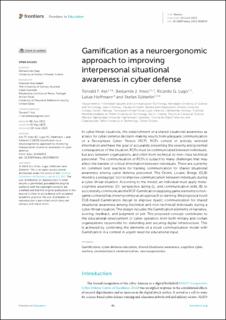| dc.contributor.author | Ask, Torvald Fossåen | |
| dc.contributor.author | Knox, Benjamin James | |
| dc.contributor.author | Lugo, Ricardo Gregorio | |
| dc.contributor.author | Hoffmann, Lukas | |
| dc.contributor.author | Sütterlin, Stefan | |
| dc.date.accessioned | 2023-11-01T08:24:19Z | |
| dc.date.available | 2023-11-01T08:24:19Z | |
| dc.date.created | 2023-05-31T12:52:16Z | |
| dc.date.issued | 2023 | |
| dc.identifier.citation | Frontiers in Education. 2023, 8, Artikkel 988043. | en_US |
| dc.identifier.issn | 2504-284X | |
| dc.identifier.uri | https://hdl.handle.net/11250/3099905 | |
| dc.description.abstract | In cyber threat situations, the establishment of a shared situational awareness as a basis for cyber defense decision-making results from adequate communication of a Recognized Cyber Picture (RCP). RCPs consist of actively selected information and have the goal of accurately presenting the severity and potential consequences of the situation. RCPs must be communicated between individuals, but also between organizations, and often from technical to non-/less technical personnel. The communication of RCPs is subject to many challenges that may affect the transfer of critical information between individuals. There are currently no common best practices for training communication for shared situational awareness among cyber defense personnel. The Orient, Locate, Bridge (OLB) model is a pedagogic tool to improve communication between individuals during a cyber threat situation. According to the model, an individual must apply meta-cognitive awareness (O), perspective taking (L), and communication skills (B) to successfully communicate the RCP. Gamification (applying game elements to non-game contexts) has shown promise as an approach to learning. We propose a novel OLB-based Gamification design to improve dyadic communication for shared situational awareness among (technical and non-technical) individuals during a cyber threat situation. The design includes the Gamification elements of narrative, scoring, feedback, and judgment of self. The proposed concept contributes to the educational development of cyber operators from both military and civilian organizations responsible for defending and securing digital infrastructure. This is achieved by combining the elements of a novel communication model with Gamification in a context in urgent need for educational input. | en_US |
| dc.language.iso | eng | en_US |
| dc.publisher | Frontiers Media S.A. | en_US |
| dc.relation.uri | https://www.frontiersin.org/articles/10.3389/feduc.2023.988043/full | |
| dc.rights | Navngivelse 4.0 Internasjonal | * |
| dc.rights.uri | http://creativecommons.org/licenses/by/4.0/deed.no | * |
| dc.subject | gamification | en_US |
| dc.subject | cyber defense education | en_US |
| dc.subject | shared situational awareness | en_US |
| dc.subject | cognitive cyber warfare | en_US |
| dc.subject | sociotechnical communication | en_US |
| dc.subject | neuroergonomics | en_US |
| dc.title | Gamification as a neuroergonomic approach to improving interpersonal situational awareness in cyber defense | en_US |
| dc.type | Peer reviewed | en_US |
| dc.type | Journal article | en_US |
| dc.description.version | publishedVersion | en_US |
| dc.rights.holder | © 2023 Ask, Knox, Lugo, Hoffmann and Sütterlin. | en_US |
| dc.subject.nsi | VDP::Samfunnsvitenskap: 200::Pedagogiske fag: 280 | en_US |
| dc.source.volume | 8 | en_US |
| dc.source.journal | Frontiers in Education | en_US |
| dc.identifier.doi | 10.3389/feduc.2023.988043 | |
| dc.identifier.cristin | 2150417 | |
| dc.relation.project | Norges forskningsråd: 302941 | en_US |
| dc.source.articlenumber | 988043 | en_US |
| cristin.ispublished | true | |
| cristin.fulltext | original | |
| cristin.qualitycode | 1 | |

